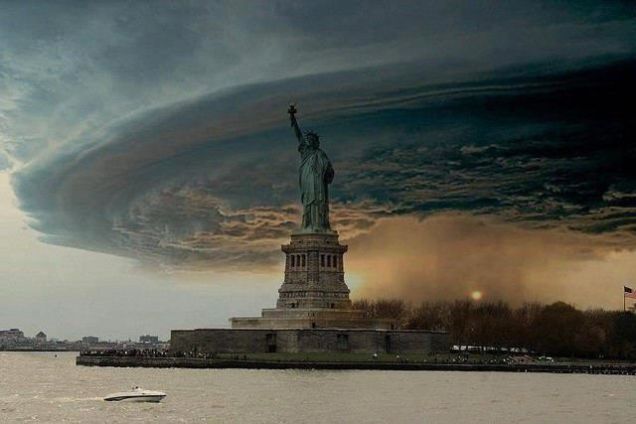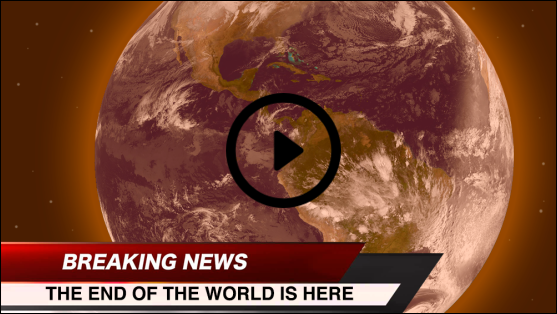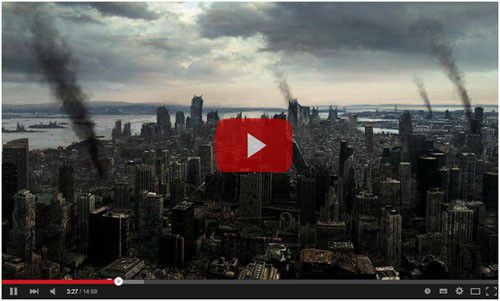The massive storm Hurricane Matthew has devastated Haiti and now threatens the East Coast, will it be a storm of biblical proportion?
As Hurricane Matthew bears down on the East Coast, citizens in Florida, Georgia and the Carolinas are getting prepared but some are being forced under armed guard to evacuate. Florida Gov. Rick Scott is warning it could be the biggest evacuation in Florida state history.
South Carolina Gov. Nikki Haley announced plans this morning to evacuate “designated zones” of what was at first reported as a quarter of a million people within 100 miles of the state’s coastline specifically to Greenville, South Carolina 200 miles inland. It has now been announced South Carolina will evacuate over 1 million people.
A fleet of 315 school buses from Greenville has been dispatched to retrieve people from Charleston and transport them back to Greenville. The evacuation isn’t voluntary, either. According to Greenville Online:
The evacuations are not labeled mandatory or voluntary anymore, Haley said. “An evacuation is an evacuation.”
One of the latest computer models for Hurricane Matthew shows the Category 4 Hurricane striking Florida’s east coast at Miami, the looping out in the ocean, . . . AND HITTING FLORIDA A SECOND TIME!
Hurricanes are one of the most destructive forces in nature. Hurricanes are enormous cyclonic storm systems covering thousands of square miles which usually develop in the tropical or subtropical latitudes during the summer and fall.
Top Ten Things to Know About Hurricanes
1.) Hurricanes are rated by wind speeds in categories:Category 1 = 74-95mph
Category 2 = 96-110mph
Category 3 = 111-130mph
Category 4 = 131-155mph
Category 5 = 156+ mph
A sharp and constant reader of our site will notice that these categories are similar to the ones we’ve sighted for tornadoes. There are differences, however. Firstly, hurricanes cannot reach the speeds of the largest twisters, which can reach windspeeds of about 320 mph; but one must remember that hurricanes offer the perfect breeding ground for twisters. A good rule of thumb: if you’re watching for or living through a hurricane, you are under threat of experiencing a tornado.
It would be an excellent idea to read our article on tornadoes as well.
The second difference is one we’ve already stated: the heavy winds of a hurricane, while perhaps not quite as immediately powerful as the biggest twisters, can remain on the ground for quite some time, attacking with constant force.
Hurricanes Constancy Can Prove to Be Deadly
The hurricane’s constancy provides its own form of deadliness. Keep that in mind as you prepare against it.2.) Determine the level of risk for hurricane impact where you live. Make plans to evacuate if and when the order is given, and know where to go.
3.) Make a family disaster plan for hurricane preparedness and practice your plan as a family.
4.) Prepare 72 hour emergency kits for each family member including pets. Check batteries and replace water and packaged food every six months. Take these with you when you shelter, at home or at a public shelter.
Has a Hurricane Watch Been Posted?
5.) If a hurricane watch is posted for your area, it only means there is a probability a hurricane will reach your area, and you should prepare as if it were coming at you. A hurricane warning however means it is coming upon you and you need shelter immediately.Hurricane watches give 36 hours to prepare, and hurricane warnings give 24 hours to prepare.
6.) Know and post the TV and radio stations that broadcast official emergency and weather information.
7.) Review your sheltering options. Special needs should check with their home health care agencies and register with the Emergency Management Office in their county.
8.) Know the locations of public shelters and evacuation centers. Find out their rules, and decide on the items to take with you. Alcoholic beverages, drugs, weapons and smoking is not permitted in public shelters/evacuation centers. Find out about pets.
9.) Wait for the official “all clear” to be issued from the emergency management authorities before returning home.
10.) When re-entry is allowed into damaged areas, be sure to have verification of your home address. Non-residents should refrain from “sight-seeing,” which slows down emergency personnel. Also beware of hazards such as downed lines, gas leaks, and sharp objects. Help your friends and neighbors. Get training in emergency response and volunteer.
11 Key Hurricane Survival Supplies
Top Ten Things to Know About Hurricanes 1) Family survival plan (how, where and when will your family meet to take shelter as hurricane warnings are broadcast?)
2) Plywood, nails (to board up windows prior to the hurricane, and also to board up damaged roofs or collapsed walls following any high winds)
3) Bottled water and secondary supplies of emergency water stored in your vehicle, in case the hurricane destroys a portion of your home where your bottled water was stored (it is wise to have more than one location to store both emergency food and water).
4) Non-perishable food (if shelf life is a concern, you can either store your own food for long term storage and get a shelf life of several years, or purchase freeze dried food in bulk from a major supplier like Wise Company, Mountain House, etc.)
5) Emergency lighting (Coleman’s “Quad” LED Lantern seperates into four smaller hand held lights; a useful tool if you have children or others in the home with you).
6) Backup batteries (because this is a disaster you are preparing for, supply yourself with large packs of D-size batteries that come in a dozen or even 2 dozen; if you have a weather radio and flashlights, also supply yourself with a “mega pack” of 100 AA or AAA batteries, depending on your needs). Why so many batteries? The worst hurricanes can knock out power for several days and possibly several weeks in some areas.
7) Inflatable life raft, oars, and manual pump (if low land flooding from tidal surges, etc. is a threat in your specific area)
h) Rope
8) Tarp (both large and smaller tarps; if a wall comes down or a roof collapses, you can use rope and tarp to quickly make temporary repairs — once the winds have died down)
9) First aid kit, medicines, etc.
10) Propane camp stove, back-up propane cannisters (in case of power outage); for a long term disaster, for the worst of hurricanes, have a secondary wood burning camp stove on hand; we recommend Solo Stove; Solo Stove is a small, compact and light weight stainless steel camp stove that has a unique design, allowing it to create a lot of heat with very little smoke from just a few small sticks, cardboard, newspaper, etc. You do not need to have firewood on hand to use it. If you do have firewood, you will need to chop it down into very small pieces (which will make your firewood go a very long ways).
l1) Two-way radios (to communicate with nearby family, neighbors, any elderly on your watch; Midland, Uniden, Cobra, and Motorola all sell good two-way radios).
Surviving a hurricane comes down to preparation and planning. Have the tools and lumber on hand to board up windows facing the wind; have at least several days or even several weeks of non-perishable food on hand for your family (stored in a safe location of your home or on your property that won’t be destroyed should a flood occur; also store several hundred gallons of drinking water so that you have plenty of water for each person in your family, and even extra water for neighbors who may not have planned ahead, who you can help in their time of need).Make plans for re-connecting with family members. Discuss scenarios where people are at work or in school or stuck elsewhere in the region when the disaster strikes.(source)
Learn The Lost Ways To Survive The End Of The World As We Know It
The Lost Ways is an iconic book of American history and is about early American pioneer survival skills. We as Americans, have lost our way. We depend on technology that can disappear in the blink of an eye. Imagine what it would be like without electricity, a car or not being able to buy food. Things that we take for granted on a daily basis. Our way of life can change in an instant. We are all vulnerable!
It doesn’t matter if you’re rich or poor, black or white. When a natural or man made disaster hits, you need to know how to survive!
We all remember the aftermath of Hurricane Katrina in New Orleans 2005. I hope we all remember! It was a catastrophe beyond words, RIGHT HERE IN AMERICA! Not in some other country half way around the world. It happened right here at home.Where was the government? It took 3 long days for them to respond! That’s a long time when you have no food or water. What will happen when the next disaster hits? I’ll tell you one thing, those people were lucky! They actually got help eventually. What if nobody came? We all saw the looting and heard about the crimes that went on. Society broke down and broke down quickly! Within a matter of days, some survivors started acting like desperate animals.
The point is, society broke down and these people did eventually receive help. The next time nobody may come. It will be up to you, if your family survives! Not the government, they don’t have the manpower for a nationwide CATASTROPHE. You need The Lost Ways book! You have to learn how to do for yourself and your family or you’re DEAD! There is only one person you can depend on. YOU!





